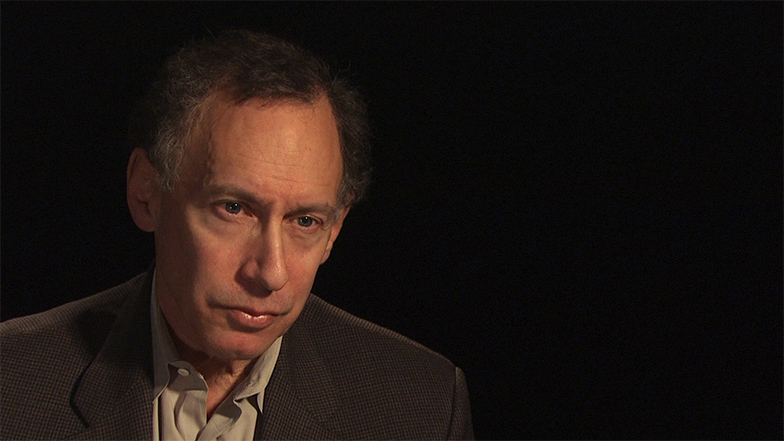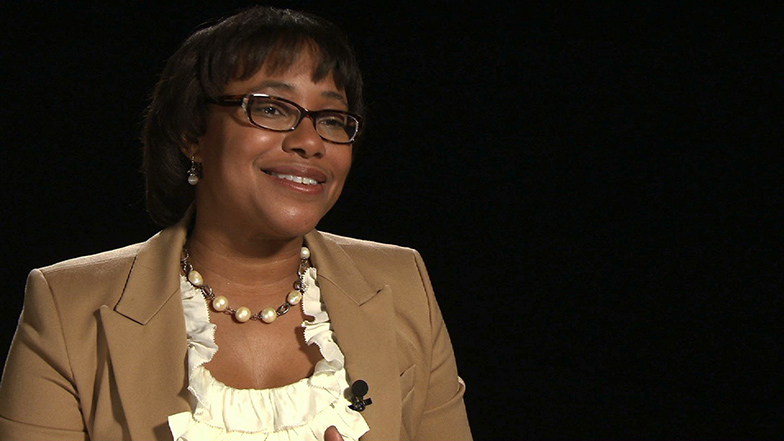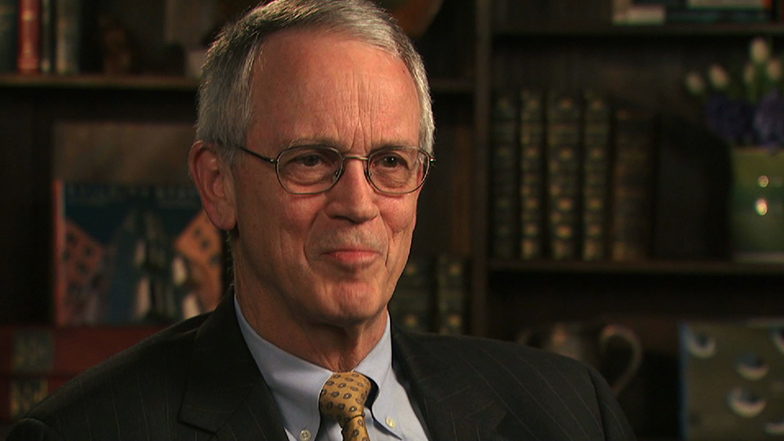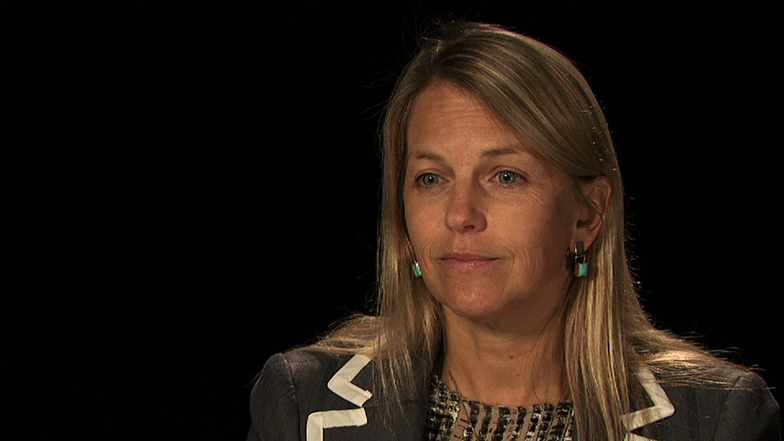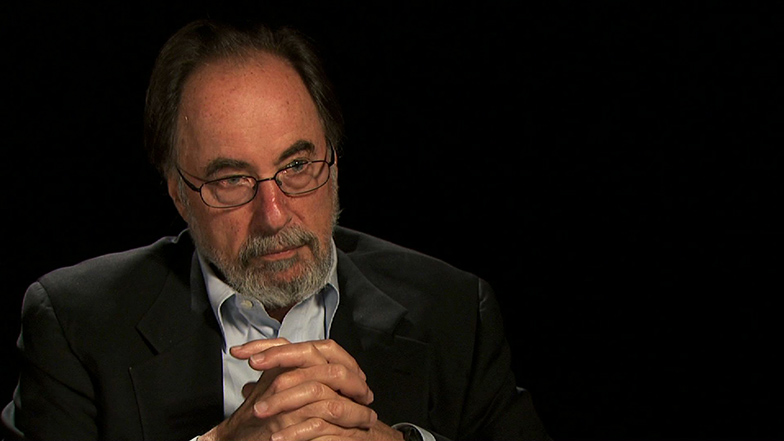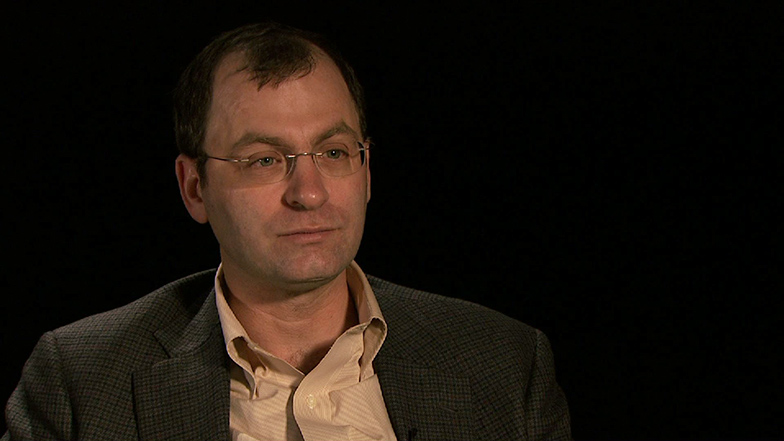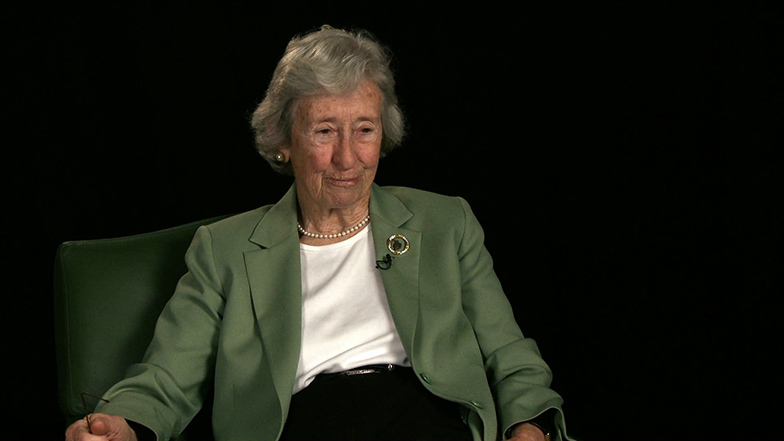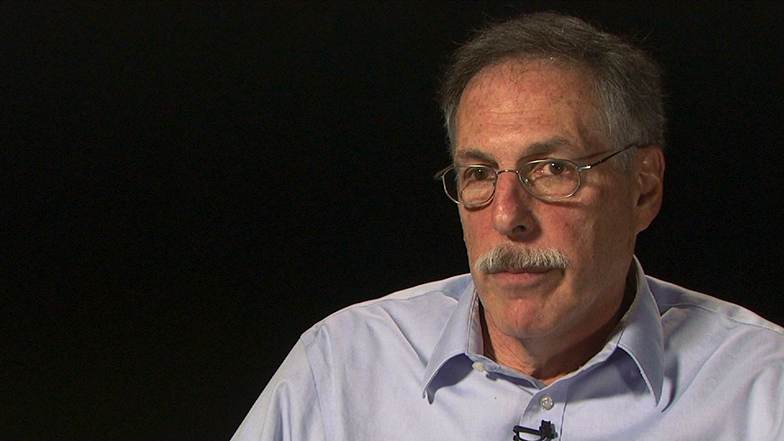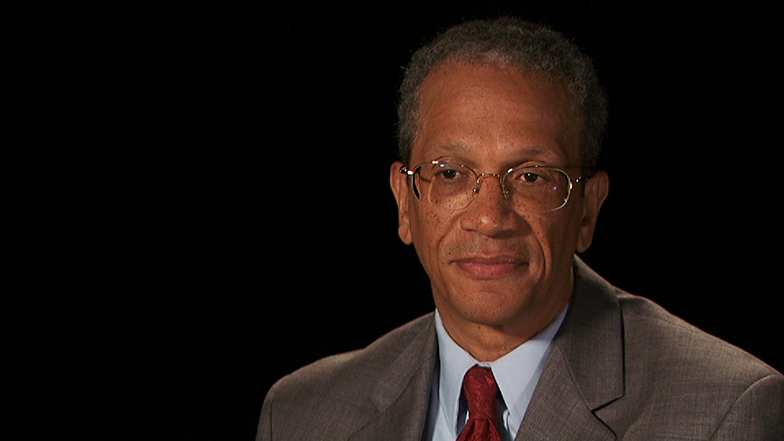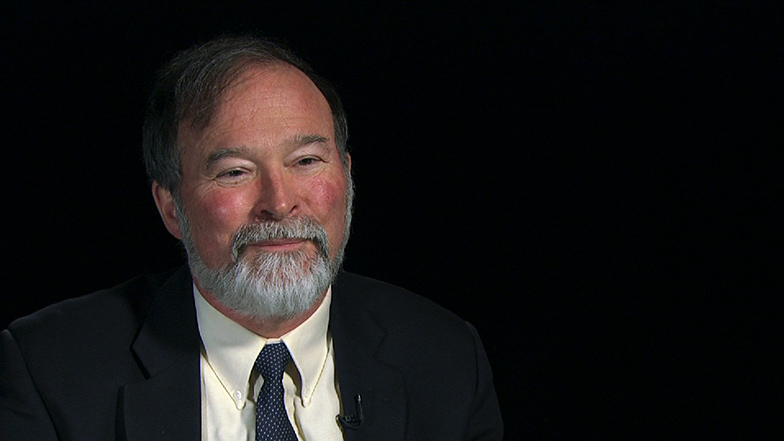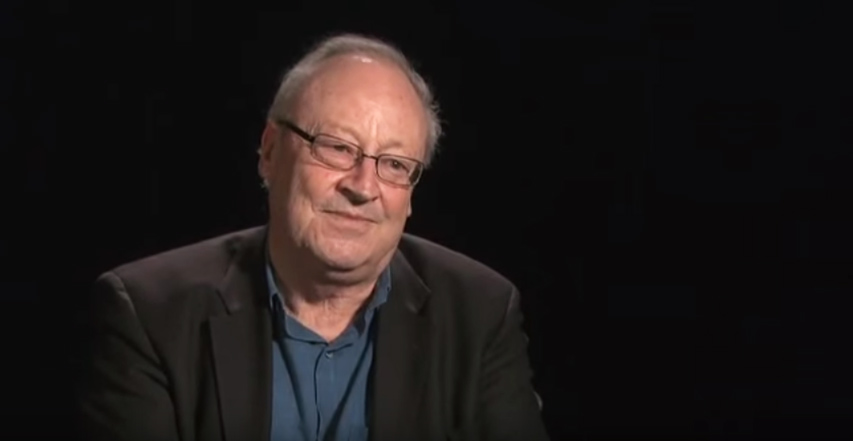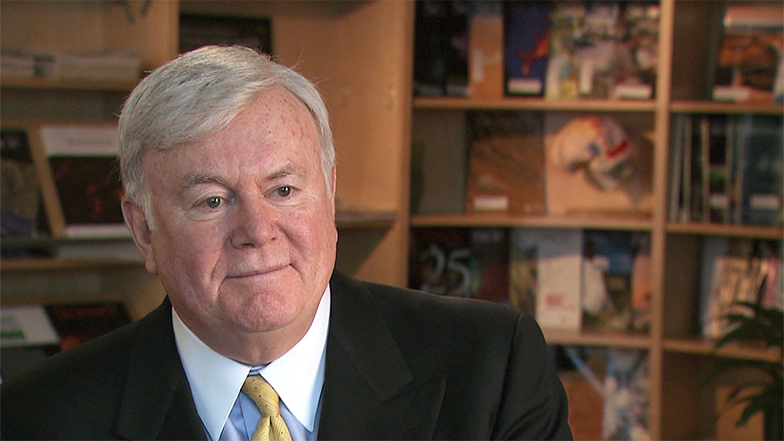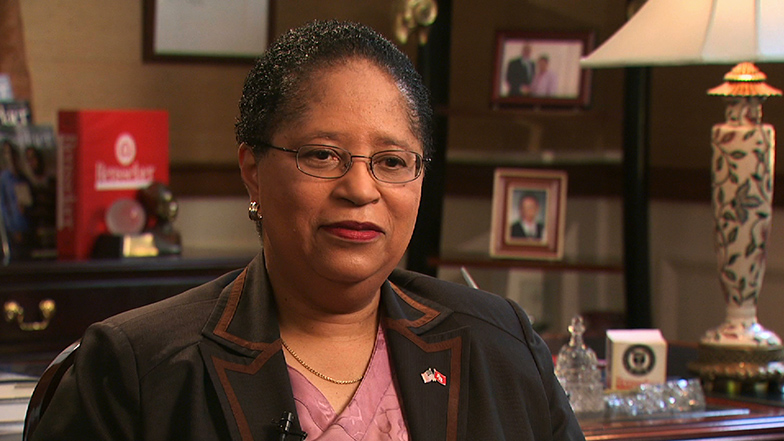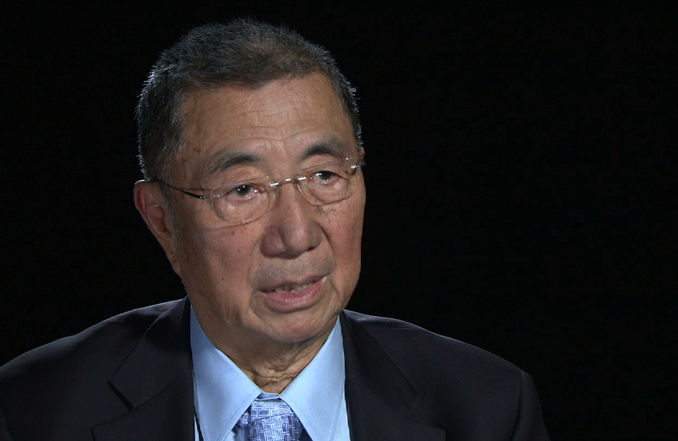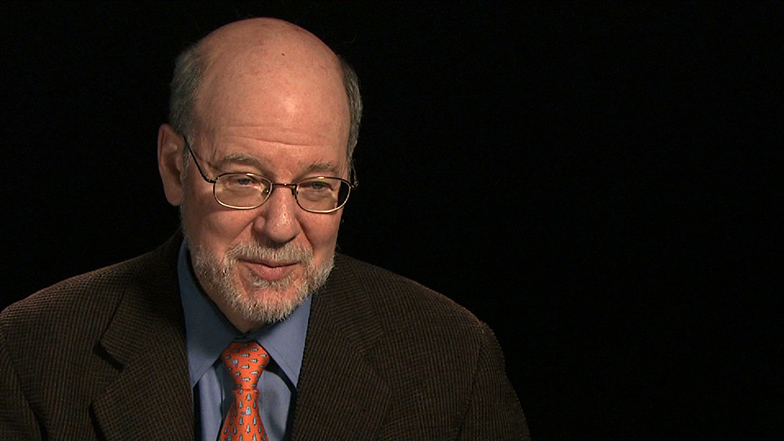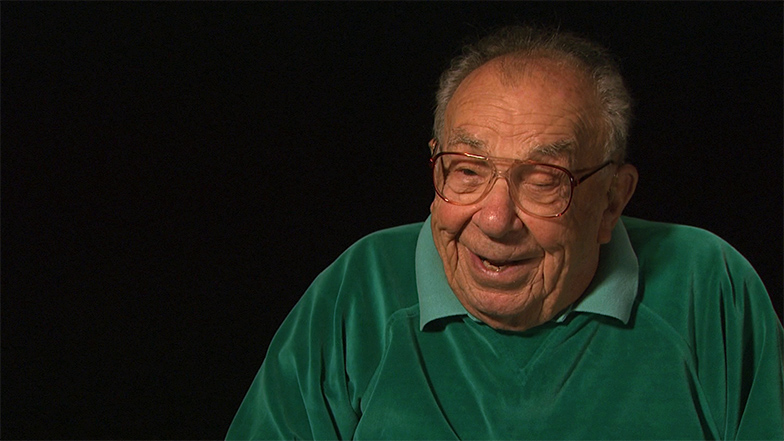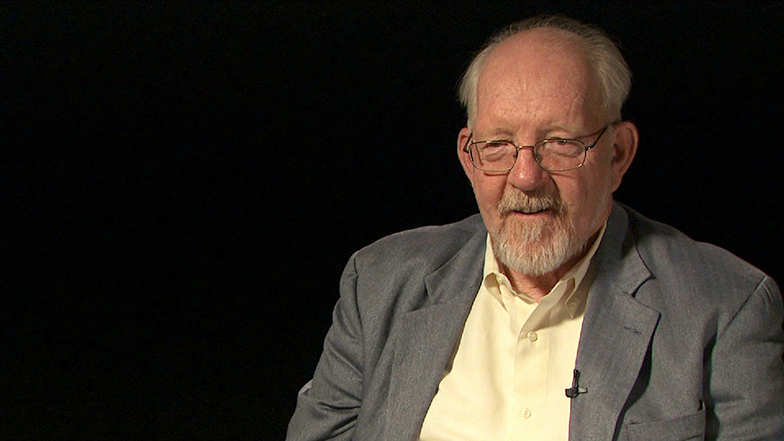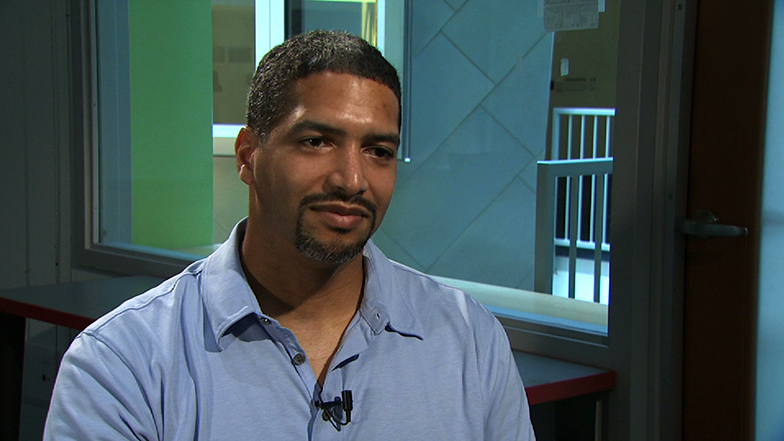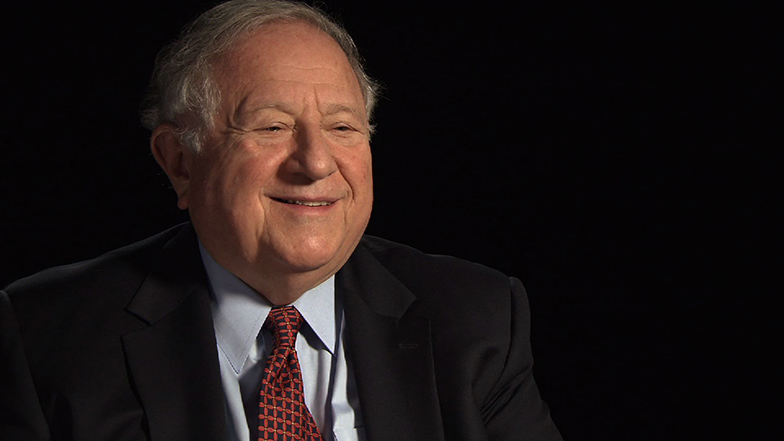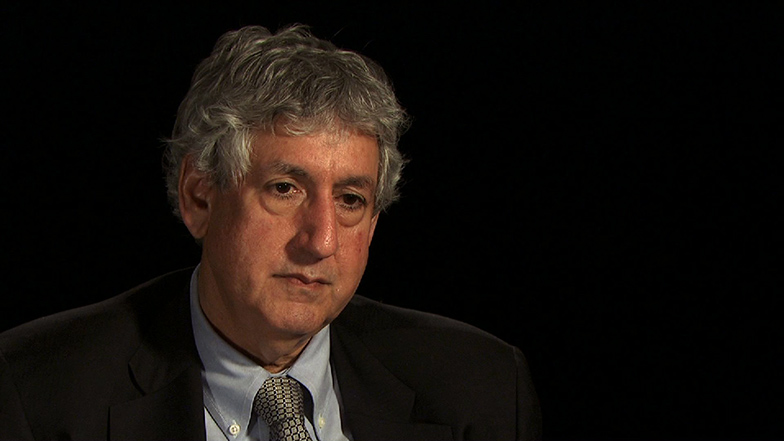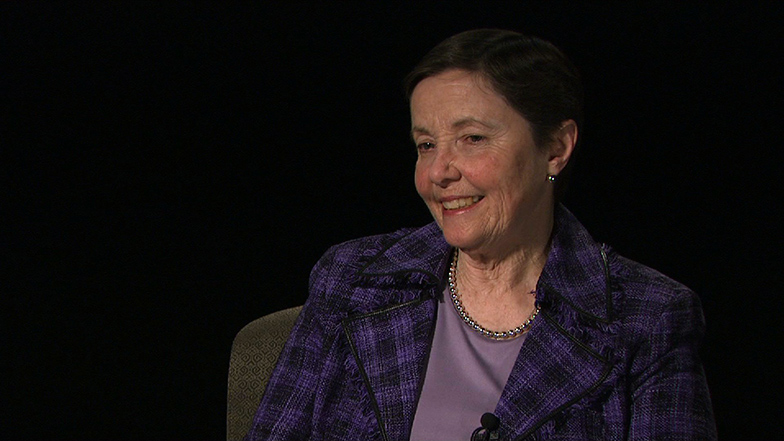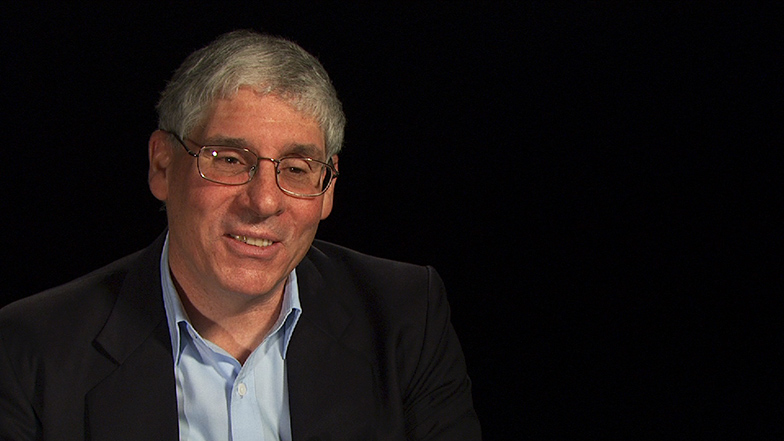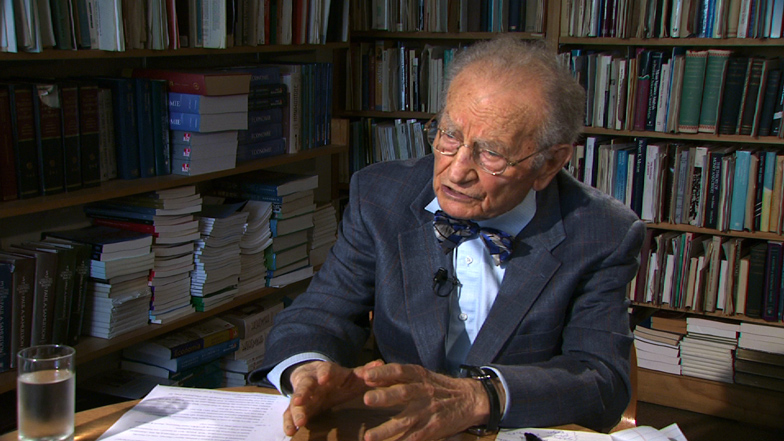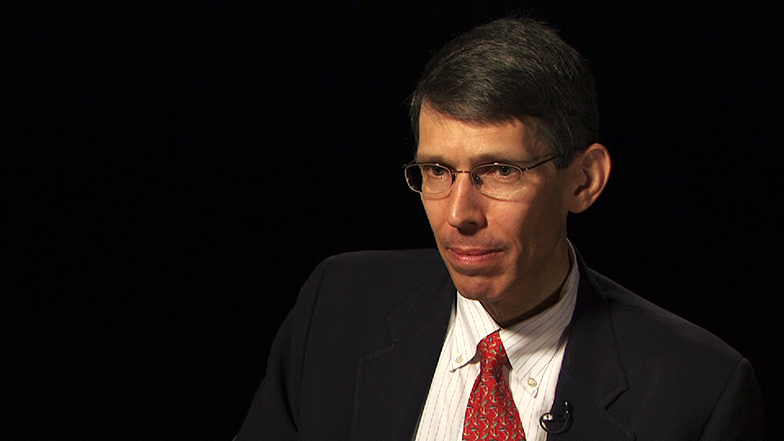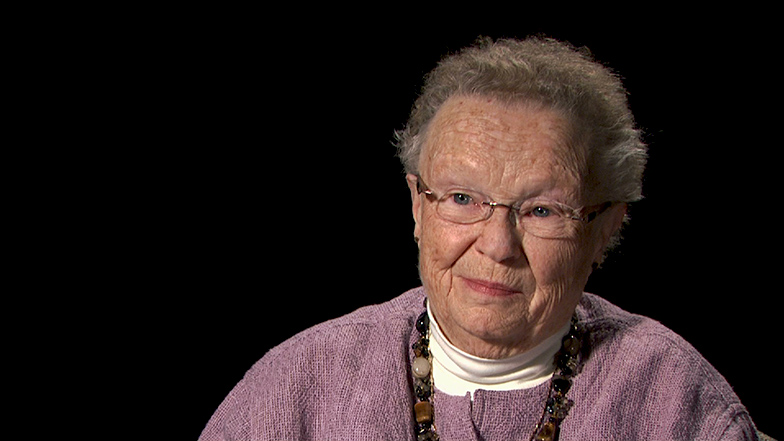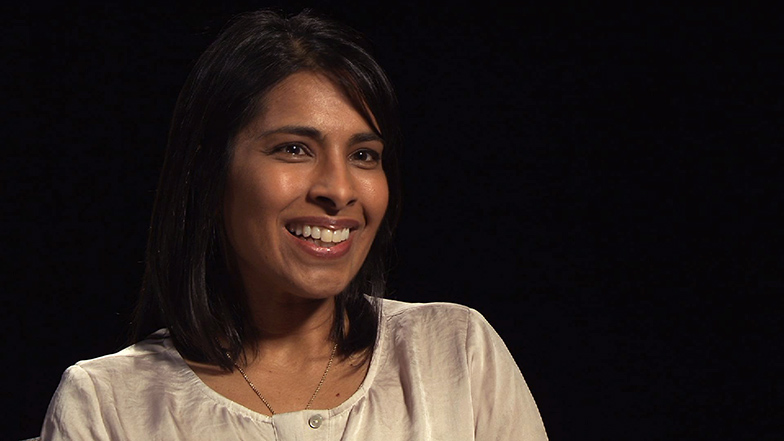Harold (Hal) Abelson PhD '73
INTERVIEWER: Today is August 23, 2011. I'm Chris Boebel.
As part of the MIT150 Infinite History project, we're talking with professor Hal Abelson. Professor Abelson is the Class of 1922 professor of electrical engineering and computer science at MIT. He holds an AB degree from Princeton University and a PhD degree in mathematics from MIT. In 1992, Abelson was designated as one of MIT's six inaugural MacVicar Faculty Fellows. Professor Abelson is co-director of the MIT-Microsoft iCampus Research Alliance in educational technology. He's co-chair of the MIT Council on Educational Technology. And he serves on the steering committee of the HP-MIT Alliance. He has played key roles in fostering MIT institutional initiatives such as MIT OpenCourseWare and DSpace.
Hal, thanks very much for taking the time--
ABELSON: Sure.
INTERVIEWER: --to talk today. So let's start at the beginning.
ABELSON: The beginning?
INTERVIEWER: The beginning. Just start by telling me a little bit about where you grew up and the early years?
ABELSON: So the real early years, I grew up on a chicken farm in central New Jersey. My parents worked on the farm. My father later went and worked in the post office. I was the first one in my family to go to college, although my parents were always very, very interested in education. My parents liked music, education. I had an uncle who sort of was the college person, who worked for Exxon and had a high level position there. So we always cared a lot about education. I'm not quite sure where I glommed onto math and science. I remember when I was I guess 12 or 13, I decided I wanted to be a physicist, mostly because I think I liked the word. But I didn't know what that was.
I did sort of okay in school. When I talk to kids these days, I remind them that when I was their age in seventh or eighth grade, I was getting D's in mathematics. In fact, like a lot of people who end up going into computers, we are really bad at doing arithmetic. Someone once said the reason a lot of people go into computers is to make up for their own handicaps in doing that. So I wasn't particularly good in any of those subjects early on. And then about the time I got in high school, I started being good at it.
One of the things the school did, they hired somebody to help me learn calculus because of course our school did nothing like that. And I don't know, sort of grew a lot of interest in math and science from there. So at some point I said gee, I don't want to be a physicist anymore. I want to be a mathematician because I guess that word sounded better.
And then I got into Princeton on a scholarship, which was nice because my family could never have afforded anything like that. And did pretty well at Princeton. Started getting interested in a subject called algebraic topology. And then got into MIT graduate school on that. And ended up coming to graduate school at MIT mostly because my wife and I were looking for places we could both go. We weren't married then, but she was looking for a place where she could go. She got into BU's School of Social Work. I got into MIT.
MIT also had a draft deferment. So back in ancient days, one of the things that you wanted to do was if you were worried that getting drafted to go to the Vietnam War, so MIT did something where I think because I was teaching or something like that, there was a category of draft deferment you could get. So we ended up coming to MIT.
And MIT was just absolutely an fascinating place. One of the nicest things, when I first showed up at MIT, we lived in Westgate. And one of the great memories that we had of being in Westgate was looking down over the field and at the other end of the field, seeing the tear gas on Mass Ave. Because that was the time when even MIT students were protesting stuff. They were protesting, for anybody who remembers, Draper Labs used to be called the Institute Labs. And there was a protest about how is it that on the MIT campus, there was classified research related to the Vietnam War? It was just sort of wonderful. Just marvelous to be here and look through this thing.
And what do I remember of MIT? I remember going up to the door on 77 Mass Ave. And gosh, they were automatic doors. And coming from Princeton, which is an ivy covered-- it's the last thing in the world you would ever imagine like that. And then there were these long, long halls. And I always had these visions of getting on roller skates and going down the halls these automatic doors. It was just a wild place. It was all one building. I didn't know quite what to make of it.
But then early on, it could have been a couple of weeks after I got here, the Students for a Democratic Society, if anyone remembers that from the '60s, that was the campus activist organization. It took over the President's Office. And they did this great thing. They had open house at the President's Office. And they were sitting there replaying the tapes so they could see what was typed on the electric typewriters in President Howard Johnson's office. And they held open house. And I said, hey, I'm a new graduate student. I'm never in my life, ever going to be able to walk into the MIT's President's Office. So let me go sit around and see what's in the President's Office.
So we walk in. And there were a bunch of students kind of sitting on the floor of the President's Office. And I see a guy that I'd been to high school with, who I knew had gone to MIT, but we'd had no contact since then. And I went up to him and said hi. Gee, hi, Ronnie. This is sort of really nice. And he says, what are you doing? And I said, I'm a new graduate student. I'm looking for what to do. What's interesting to do around here? And he said, oh, why don't you go over to the Artificial Intelligence Lab. I hear they're doing interesting stuff. So I wandered over there and talked to some people. And that's essentially how I got into computer science and AI and all the stuff I'm doing now.
And I like to tell that story to students who worry about what they're going to do when they grow up. Because I like to tell them it will be random, and you have no idea. But at some point, some totally random thing will happen that will have a tremendous influence. So don't worry about it too much.
INTERVIEWER: So backing up for just a moment, had you done work in computer science before that at Princeton, or even previously? How did you first--
ABELSON: Yeah. At Princeton I did-- well, there sort of wasn't a computer science major then. In fact, I'm not even sure there was one at MIT when I showed up. But at Princeton, a bunch of us worked in the computer center. And the Princeton Computer Center had an IBM-- I think a 7.090 or 7.10. It got one of the first 3.60s. And they were working on this very weird thing called time sharing. And a bunch of us went around and messed around with that and did what most of Princeton considered to be a totally worthless, stupid thing with computers, which is actually using it for text processing. Because everyone knew that what computers were really for were solving big complicated equations. And the computer center used to take down the system a couple of hours each week and let those of us who wanted to screw around and waste time, play with this text editing thing. Get tremendous complaints from the astrophysics department because people had to stop trying to solve on science equations.
So I became one of the people who were messing around with that. And I became a little bit of a consultant, an undergraduate consultant in the computer system, teaching people to migrate their programs from FORTRAN to a language that IBM and a couple of other places were pushing then called PL/1, a very modest name, Programming Language 1. And this was supposed to be the be all and end all of the new computer stuff. And there was a big move to say you should translate all your programs into PL/1. So I became one of what was called the PL/1 kids and would consult with faculty in the other departments about how to modify their programs.
So I had some stuff in computing and I knew about that. I knew very little about what I actually went into at MIT. But it was a background in computers, enough to walk into the AI Lab and do interesting things.
INTERVIEWER: But at the time you came to MIT, initially there was not a sense that you would be moving in that direction?
ABELSON: No, I was in the math department. And I was a graduate student in the math department, became an instructor in the math department after that, and only moved into computing later on because some of the work I was doing in topology was related to distributed computing. And then sort of the topology part of it atrophied and the computing part of it grew. And eventually when into computer science.
INTERVIEWER: So you mentioned the AI Lab. Talk a bit more about working there and also you worked with Seymour Papert in the Logo Lab as well, right?
ABELSON: Well, that's actually how I started in the AI Lab. For some reason I went-- there was an early Logo presentation called I think Teaching Children Thinking, which was in 26-100. And it was this big thing where Seymour Papert and his assistant for many years, Cynthia Solomon, talked about the Logo computer language and showed the Logo turtle. And I looked at it and it was pretty fascinating. And pretty wild. I remember later on reading a report from a journalist who's been there. And her mind was just blown about this notion that children should do these weird robot things. And I remember her saying, I looked at this thing and I thought these people were witches.
But anyway, I thought they were cool, whether they were witches or not. And I walked over to the AI Lab, looking for something to do. And walked into the elevator. And then elevator stopped at one of the floors and then Seymour got in. And I said, hi, I like your stuff. I'm a new graduate student. Can I work for you? And he said, yeah. And that's how I got into this whole business. So another bunch of random events.
INTERVIEWER: So you've talked a little bit about what it was like coming to MIT in the late 1960s, what your impression was of the campus. But give me a little bit more information about sort of the culture and the environment at that time. I mean obviously it differed as you've said from Princeton and was unlike other things you'd seen.
ABELSON: Well to me, it was really strange. I mean MIT is such a big complicated place. I've often thought that well, after being here about 20 years I finally got the ability to think of the place as a whole place. And I just don't even know how it's possible to do that because there are just so many things going on and it's so complicated. But my impression from Princeton is that it was very strange and very regimented.
So I remember hearing about the Experimental Study Group. So what people told me about the Experimental Study Group was that it was a place where you could learn on your own and do stuff that's independently and it was very open. And I remember going over that, because I had some friends who were in the ESG. So what do you do here? What do you do that's independent? And they said something like, well we get to take the standard course curriculum, but we get to study it by ourselves.
And I just remember breaking down laughing. I said, that's this place's idea of what independent learning is? Because I'd been in a program at Princeton, a very '60s program, I think even Princeton stop doing it, where they admitted you. And they said hey, you're a bunch of smart people. You have no requirements. You had department requirements. But the rest of the time, Princeton's a big place, take what you want. And all of the standard things you'd call distribution requirements or university requirements are just abolished for you. Some of us totally exploited it. Some of us had a great time. I ended up with a couple of friends essentially living as graduate students in the math department.
But coming from there to MIT, it was this sense of being regimented and precise. Later I've come to identify that as an engineering culture. I see the same thing happening at Google, because I've been spending time at Google. So you see this culture and you love it. I mean I just love engineer's culture. I'm an engineer and I do that. But one of the characteristics of an engineer's culture is you sort of sit and you say, what's the problem, what are you're trying to do? And then about three seconds later you say okay, what's the solution? And you think for about two minutes and you figure out the solution. And then you just drive to that solution as fast you can. And looking back, I recognize that's how I reacted to MIT. So there was no sense that the requirements were wrong or any of that. It was just we figured out this is the way to do it. And now we are just going to drive to that as effectively as we can. And MIT's kind of like that. And there are wonderful parts about that. And there are sort of bad part of that.
INTERVIEWER: Tell me a bit more about working with Seymour Papert. What was that like?
ABELSON: Well, Seymour was, is amazing. So I guess people know that tragically he was very severely injured in Vietnam. And his brain was very affected. And he's under rehabilitation now. But Seymour was just absolutely amazing-- I mean his childlike sense of wonder at learning. And what Seymour really is about is learning. So people talk about computing and people talk about math. But with Seymour you are just surrounded by this joy of being able to learn.
So it's not just math and things. It's things like, he taught himself when we were there how to work on the bongo board. There's some old AI Lab historic tapes of Seymour doing the bongo board. And what he loved was to explain to people how you thought about how to balance on the bongo board. He also did it with juggling. So he sort of had a tremendous-- teaching people to juggle. And his idea was that you could think about that. There was a method for thinking about how you juggle. So this thing that looked like a very complicated thing that a circus person was doing, it almost magic, you could actually teach it.
And everything he did was infused with that. I remember going to visit him in Maine. And he wrote this map. And the map, you could tell that he enjoyed writing the directions on this map in a way that people would understand them. And of course that went over into math and science. So he had exactly the same philosophy that learning about math and science isn't magic. There's a deliberate, in his way, procedural way of thinking about knowledge and about learning. Another critical part of that is the notion of debugging. So there's this idea that you do something, and you make a mistake. And he would always totally emphasize that mistakes are wonderful. Bugs are just great because that allows you to go back and analyze and think about stuff.
And all of that influence went not only in my own work in education, but also in the computer science work that Gerry Sussman and I did. There's this thing called the procedural explanation of knowledge. One critical thing in teaching people ideas, whether in computer science or anything, is to give them names and to use those names and things. And that goes right through all of our work in the Scheme programming language and our work in making MIT's first computer science course. It goes absolutely, directly back to Seymour.
INTERVIEWER: Were there other key mentors or professors that influenced your development, your intellectual or your professional development as a graduate student.
ABELSON: Oh well, sure. I mean I wasn't a graduate student in computer science. I didn't work for Seymour as a research instructor. My research was actually in mathematics under Dennis Sullivan, who is a very, very famous topologist, who was in the math department at MIT in those days. And again, he was a little bit different. Dennis was one of these mathematicians who's just magic. You look at this thing and you say how could this guy possibly have ever thought about this stuff? And he was just an enormous influence about-- just sort of this intellectual excellence where the stuff springs from nowhere. And you're just inspired that way.
INTERVIEWER: So tell me a little bit more about your professional path from mathematics to computer science and from getting a PhD at MIT to being a professor at MIT?
ABELSON: Oh, sure. Well when I got a PhD, I was in the math department doing topology. Got an appointment as an instructor. But then because I was working in Logo, MIT started something in the mid-'70s called the Division for Study in Research and Education. And it had a couple of key pieces to it. There were three leaders. One was Ben Snyder, who wrote a very famous book at MIT called The Hidden Curriculum, which is all about how surviving at MIT is a process of constant triage. And students at MIT have to learn that. One's Don Schon, who was in the Sloan School, who was very famous for his theories of knowledge or ideas of espoused knowledge and how you do things. And the third one which was Seymour doing Logo. So I became part of the Division for Study in Research and Education. Got a joint appointment in math and DSRE. And that's where we sort of really started to do Logo work as sort of real MIT research kind of stuff.
But then eventually what happens, MIT decided to close down DSRE. I was sort of too junior then to understand or even be aware of the politics behind that. But in any case, MIT decided to close it down. And then I moved into the electrical engineering computer science department, kind of on the basis of the Logo work and the basis of the fact that I was doing distributed computing. And that's sort of where I've been sitting.
INTERVIEWER: So tell me a bit more about the early Logo work and your work in distributed computing and how that has sort of influenced your research path since?
ABELSON: Well, I don't actually think about Logo and distributed computing together very much.
INTERVIEWER: Well, we can treat it separately I suppose.
ABELSON: Other than they kind of both end up being a vision of computing and being formal about it and things. The Logo work was as I said, magic. It is really hard right now to go back. We're talking a dozen years before the personal computer.
What we used to say in Logo is oh my god, if a computer could just cost $10,000, that would revolutionize all of education. Because what we were doing is these were million machines, a million dollars in 1968 dollars. They were sitting in the Artificial Intelligence Lab, doing the world's very best, fanciest research an artificial intelligence. And we were hooking them up over phone lines to be used by sixth graders in Lexington, Massachusetts. And just a totally outrageous thing. One my first projects as a graduate student was working on a remote display that you could hook up that could sit in Lexington and move over a phone line. And so students could write what was effectively the first Logo turtle and draw designs on this graphics display. So that was like my first job as a graduate student, implementing that.
But it was so off scale. Just the very idea that a computer would be something that a kid could use. We take it so it for granted now that it's almost impossible to put yourself in that mindset. So most people thought we were crazy, because I mean what a weird thing. Why could a computer ever be something that would be relevant to a kid, much less programming it or anything? And it was a mixture of what happened in the AI Lab. Every couple of weeks somebody would run in off the street saying, I want to see the robots. You're making robots. I want to come see them. And AI Lab was just a wonderful mixture of that.
So it was run by Seymour Papert and of course Marvin Minsky, who are just two completely brilliant people with I think a real sense of faith, in that if you're surrounded by a lot of smart people and you give them a lot of freedom and your job is really to inspire people, it will do great things. And the AI Lab was just infused with that. There was just a tremendous sense of community among the AI researchers, which was partly true because it was pretty small. One of the things that's happened more recently is that merged with the Lab for Computer Science. And it doesn't have that same real sense of community and flexibility.
But the original AI Lab, there have been a much of books written about it, all sorts of things emerged from that. The other thing that emerged from that, that maybe you want to talk about later is Richard Solomon and the whole free software movement, which these days is better known as the Open Source Movement. But that was a thing-- I mean in a deep sense it had to do with computer science, but not obviously. But it's a whole kind of philosophy that grew out of this sense that technology is fundamentally a data community and fundamentally about a whole bunch of inspired people sharing and building on each other's work. And that of course goes way past software into things like Creative Commons and lots of the stuff that we see now. But it came out of that germ of sharing around a technology community.
INTERVIEWER: Yeah, I want to definitely in a little bit explore some of these broader ideas in their current form. But let's talk a bit about that culture of sharing and of open networks within MIT at that point. I mean I've read that obviously there's a whole sort of different landscape of security and passwords or lack thereof. But just describe the environment a bit more at that time and how obviously it had effects later.
ABELSON: Well remember for thinking about now, the internet-- it wasn't an internet then-- the ARPANET was a small place. And it really was a very small, very, very homogeneous place.
I like to tell people I've had my email address since I kind of knew all of the people that I could have send email to. I mean it's been written a lot that people who originally designed the internet said they just sort of did not design the internet architecture to think that there would be bad guys out there. Because they knew all the people. All the people were like them. And that reflected over in passwords. I remember there was one sort of dark day when the people from ARPA said, you need to put passwords on your accounts because they're on the network. And for security, you need to do that. And a whole bunch of us were just convinced this was a horrible idea. I mean what a terrible idea that you'd have to put a password in an account and people could get into it.
I remember Richard Stallman reacted to this by making his password RMS, which was initials. So just jumping ahead a little bit, if you move about 10, 12 years later, my daughter, when she was about oh 14, introduced me to what became known as MUDS or multiplayer games on the internet. I had no idea this thing existed. And I was introduced to this by my, what she then, she probably was maybe about 13. And I come home and she says daddy, do you know there's this thing on the computer that all kids in the whole world can use? And I say, gosh no. And she says, I'll show you. And she says you have to dial this phone number. So she starts dialing this phone number. And I say, oh my god, that's my lab at MIT. That's the terminus server to my lab at MIT. And she says yeah, you have this thing. And it types out this funny star or something. And now I'm supposed to type R-M-S. And I say, oh my god, you're typing Stallman's password to get into the system.
And she goes from that and starts up playing this game. And it was great. She had no idea that this was MIT. She had no idea what RMS meant. But there were kids all over the world who were doing this. And that's a little bit of the spirit of sharing and openness and delight that comes from that. That's just really hard to do now. Because again, the network is a much less homogeneous place than it used to be. But that's a little bit of what that AI Lab kind of spirit I remember, just to give you another little anecdote about that, that's fun.
I don't know if you've interviewed Joel Moses?
INTERVIEWER: Not personally, but yeah.
ABELSON: So Joel Moses at that time was the head of the symbolic mathematics project. That's really the great thing that he did, before becoming provost, sort of inventing symbolic mathematics. And there was a whole big dispute between him and one of his ex-students who had gone to Berkeley. And there was a dispute about who should get access to this Maxima program and should it be licensed and not licensed. And there was a fairly heated email exchange that went between Joel and Rich Fateman. And of course, everyone could read everybody else's email at that time. And they decided that people in the lab were wasting so much time reading Joel's email that they simply translated all of Joel's email to message of the day. So you all saw it when you logged on. And that's a little bit again, the sense of playfulness and openness and we're all part of this big community and the computer system is a way of empowering that.
And I do believe that had a whole lot to do especially with the development of time sharing. In a sense sort of Bob Fano and Corby Corbato, when they started the time sharing project, it was sort of about technology. But pretty soon they realized really what they'd done is create a new kind of community. And to their credit they recognized that very, very early and pushed the sense of gee, there's a thing like community. There is an information community. MIT was one the first places that really did that in a conscious way. And again, this all comes out of the same kind of culture of openness.
INTERVIEWER: Yeah, we'll return to the whole question of open networks, Open Source a bit later. I want to turn a little bit in a different direction and ask a bit about your interest and professional development of teaching computer science, of the development of 6.001 and also your work with Gerald Sussman and the book.
And maybe, I don't know if this is a productive way of leading into it, but it's a question I'm really curious about. You mentioned very early on that when you were growing up, you were bad at arithmetic, but found out later that you were good at math. And I think that's very fascinating. How does one think about math in a way that makes that true? I mean they're impossible that could be bad at arithmetic, but good at math.
ABELSON: I don't know. I don't view arithmetic as having very much to do with math in fact. And I think there are a lot of people in kind of the same boat.
Again, there's theories that people who go into these developmental fields are doing it in some sense to make up for their own deficits, to try them. So I sort of view it kind of that way. But again, I've always been interested in puzzling out things and explaining things. I wasn't very much interested in teaching until I, gosh, until I got to MIT in fact. But it was mostly explaining things to myself. Being in a couple of very good summer high school programs, one at University of Notre Dame, which has since moved to Ohio State, which had a long, long, long track record of inspiring people in mathematics. One at Cornell, in physics. So that's another kind of educational link that I was exposed to.
And later, my colleague Andy diSessa and I ran that kind of summer high school program at MIT around computer science and Logo and teaching things. So I've been interested in education kind of from that perspective.
I've also played around with computers in education. One of the things I did in the math department was I was teaching linear algebra. And I think just for the heck of it, I did what must have been one of the very first MIT computer exercises where students used the Multics computer system in those days to do some exercise at the end of the day about matrices. Now I didn't know what I was doing. And it wasn't particularly good and wasn't particularly successful. But it was kind of foray into saying, gosh these MIT computers might actually get used in courses. Not much of that happened for a long time after that though.
INTERVIEWER: Thinking about teaching computer science specifically, can you talk a bit about the Structure and Interpretation of Computer Programs and what that grew out of and what the sort of fundamental concepts are behind your approach?
ABELSON: So Gerry Sussman and I, I think were really privileged in that we wrote a book that really was able to draw on that whole of a 20-year history of how MIT and that whole AI culture thought about computing. And it goes directly back to again Seymour Papert and Marvin Minsky. And it really has to do with-- what's the phrase we used-- a computer program is a way of expressing ideas and communicating ideas, and only incidentally about getting a machine to do stuff. That is straight out of-- I don't think Seymour used those words, but that's straight out of the Logo philosophy of we're teaching you-- like I talked about juggling before. This really is, what's the procedure for how you juggle? And critical in being able to do that is having the right set of words and having the right descriptive framework for saying things like that. And so the key idea in Structure and Interpretation is what we ended up calling the linguistic approach to programming design, which says if I would like to do some very complicated thing, one of the critical tasks is picking the right descriptive framework for saying that.
So there is a complete blend. I think somewhere in that book we wrote that when you make a complicated program, you're actually designing a special purpose computer language to solve a problem. And it comes through in lots and lots of ways. So it goes back I think to the AI culture, which has the property that you don't quite know what problem you're solving because these things are really complicated. It's not as if someone says compute the total payment on this mortgage where you know exactly what you're going to do. Rather it says, you want to be mucking around in this area to solve this problem and lots and lots and lots and lots of similar problems.
And that permeates both the design of the book and the actual programming technology that people use. So the style of programming languages that go back to LISP is really sort of muddier. It's not a very precise kind of thing. You make ways of programming things where you're solving not just one problem but a whole family of problems in that.
And again, it goes back to very, very technical things, like LISP is a very good language for creating other computer languages. Because when you're programming in LISP, you actually have the mentality of gosh, I'm actually creating some special purpose language to solve not just one problem, but lots of them. And that's the critical idea in Structure and Interpretation.
I mean we can't take credit for that. We were just blessed that there was a whole tradition of 20 years of really deep thinking at MIT and a couple of other similar places. And we sort of got to be the people who got to put that in the book. And it's had enormous influence, but it's not because of us, it's because the tremendous power of those ideas and the communities that they came from.
INTERVIEWER: So moving beyond those communities that the book and that thought process came out of, did you encounter resistance, maybe that's not the right word, maybe misunderstanding-- people who were focused on the syntax?
ABELSON: So we published this with MIT Press. And MIT Press sent it out for reviews. And the first review came back. And I'll never forget. It said, quote, the question is, is in MIT Press publishing this book going to advance or set back computer science? So there was a lot of resistance to this because it's just very different. And there's a lot of people who really don't believe in that approach, who really do think it's the wrong thing. Because again, it's this notion of you don't actually focus on solving this problem very, very, very precisely.
There's a whole movement in computer science, a tremendously respectable one, and it says a program is like the proof of a mathematical theorem. And there are people who do prove things about programs. That in some sense is the mainstream almost. Whereas we're saying well, a program is sort of like a language. Like you can say lots of things. And I don't imagine I'm going to prove everything I'm going to say. It's just that the great thing is I get to see all these different things. So we've had a lot of influence, but I wouldn't even say that we're mainstream, even now.
INTERVIEWER: From my limited experience when I think back to my computer programming classes, it was more like the mathematical theorem approach. Yeah.
ABELSON: Exactly right. It is.
INTERVIEWER: So talk about 6.001 and the development of that class, which is obviously closely related to the book, right?
ABELSON: Gosh. So the other person who really deserves enormous credit for this is Bob Fano. There was a tradition of, what was the first MIT computer science course? There was one taught by Mike Dertouzos and Steve Ward for awhile. But when I got involved with this, Bob Fano was teaching this. It was called 6.035. And what was it called? I think it might have been called Structure and Interpretation of Computer Languages. And it was very focused on, here's this kind of language. The language then was ALGOL people used. And then it did a little bit of LISP. And it was kind of an okay course. Mostly famous because it was the first course.
But Fano did say the key thing. So I talked about what you're doing is making a language and how you make languages to make languages. The technical term for that is an interpreter. So an interpreter is something that effectively takes the description of a language and lets the computer effectively speak that language. And Fano was very-- I mean he would say this in his lectures. I don't think any of the students got it. I didn't get it until like the third time through, where he sort of said the really, really key thing is that you build up complexity by constructing an interpreter. And again, that's the core idea of 6.001, said in a slightly different way. So he had an enormous, enormous influence on us, but also more directly.
So about this time, there was a tradition in the electrical engineering computer science department of when the department did the transition from kind of power engineering to signals engineering in the late '50s, led by people like Ernie Guillemin and those sort legends at MIT, there was a very, very influential series of textbooks that came out, I think in the late '50s, early '60s, that almost sort of set the academic marker for the field of electrical engineering.
So when we were there in the in the late '70s and very beginning of the '80s, Joel Moses and Gerry Wilson wanted to do that again. So there was this notion that there would be a series of new courses and new books that the department would put out. And then what was going to be the computing one? So Fano basically backed that Gerry and I would do the computing one and do the computing course. And again, there was a lot of a lot of controversy there because people didn't believe it. Fano was sort of the power in the department who really made it possible for us to do that. Gerry and I sort of happened into this. So we were sort of lucky. And just very, very fortunate that there were some smart people backing us.
INTERVIEWER: How has introductory curriculum in ECS changed since that time? I mean clearly it's--
ABELSON: Oh, it's changed a lot.
INTERVIEWER: Yeah.
ABELSON: I don't know. People keep using the phrase bittersweet. It's changed in style. So what happened in the department is the department kind of decided that the way students get introduced into the department should become more horizontal and less vertical, by which I mean when you go into the department before the new curriculum, there were a bunch of very intellectually deep courses. So 6.001 really is a deep course in software engineering. And then the idea was well, you shouldn't actually do that because if students want to think about what they want to major in, they ought to get an experience that's a lot more broad. So they should learn not only about software, but something about circuits and something about signal processing and all that. So 6.001 sort of didn't fit into that world.
I sort was on the committee. I had this funny feeling. I sort of loved the course. But I also had this feeling that the course needed to change. And both Gerry and I felt that as long as we were part of it, it wasn't going to change. And in fact we consciously got out of it. We had an official, what you call passing of the baton ceremony in one of the lectures where Bob Fano was there as the originator of this, who let us do 6.001. And then Eric Grimson and Duane Boning were there. They were going to take it over. And we kind of officially passed the baton. And we said we now did this in front of 350 student witnesses. We are never going to teach this course again. The department can't ask us. But then what happened is even after we got out of it, the course didn't change as much. And we can flatter ourselves and say well, the ideas were just really great. But sometimes you just need a kick in the pants to go someplace else.
So this new department curriculum structure turned out to be the kick in the pants. And so I was part of the group, along with Leslie Kaelbling and Jacob White and Tomas Lozano-Perez, who sort of designed sort of the new course, which consciously was not about 6.001. But a lot of the biggest themes of 6.001 about extraction and modularity and the way you express things, they carry over into the new course. But the new course is also doing robotics. And it's thinking that signal processing. And there's even some stuff about circuits. So it's not a deep course in that sense.
And there's a lot of people who have come through MIT-- I don't want to take credit for 6.001 and that, but I want to say it was a very deep experience in how you think of software-- who criticized what we did. And they say they really miss it. They talk about their own intellectual development as programmers. It was just profoundly influenced by that kind of very-- we would sit in that class and talk about the philosophy sometimes. The new course does not do that in the same way.
On the other hand, you have to sort of ask what's the population you're serving? And the fact that you talk to the minority of students who really, really glommed on to our way of thinking and they say, gee, we really wish MIT were still doing that. I don't know what the right way of serving the most students are. But in any case we're just doing something rather different in motivation now.
INTERVIEWER: So it's broader, but less deep.
ABELSON: And very consciously less deep.
INTERVIEWER: Right. What are MIT students like? I mean how do they respond to the deep dive on the one hand or the sort of broad fire hose on the other of having to deal with all of these different things?
ABELSON: I think you can't generalize. Right. There are certainly some, I'm going to say kind of the mathematical ones. So even though it's not mathematics, that kind of deep thing is a math kind of experience. And they really would rather have something that's more like the original 6.001. But then there are a whole bunch of others who just want to-- I just want to understand the breath of this field I'm getting into. I don't want to just because I'm going to major in electrical engineering, have to take a whole semester of this other stuff, most of which is kind of irrelevant to me.
So again, I don't have a good sense of how the students are feeling about the population it's serving. Because we did this other thing at the same time, which as far as students I think has a much bigger impact. So there's a whole other stream which we haven't talked about at MIT and active learning, which comes from the stuff I've been doing with the Educational Technology Council.
But we made a radical, radical change in the style of the course, which was removing most of the lectures. So in the new course, the main thing you do with your time is you work on a project. And there's a big giant open lab. And the entire teaching staff of the course is present in this open lab. And there's kind of a pyramidal structure where there are undergraduate laboratory assistants, and each group of them is kind of supervised by a graduate student TA, and each group of graduate student TA's are supervised by the actual course faculty. And we're all sort of mixing it up in the course and sitting there talking to individual students. So rather than sitting in lecture, it's this very kind of open, interactive project-based thing.
And that's such an enormous change in style, that when you kind of ask the students well, do you like it more, how you react to it more, that's got to dominate what we were doing in terms of content.
INTERVIEWER: Yeah. I want to actually ask a whole set of questions on educational technology and the developments you've been involved in. Before turning to that, at the risk of asking to generalize again about MIT students, is there any way of talking about how or whether MIT students have changed over the course of your career?
ABELSON: Oh, god. You get the feeling that about every three years there's a new generation. So the main way MIT students have changed I think is that they're more docile, as much as I hate to say. Marilee Jones, who was admissions director, actually thought about this a lot.
Remember in the '60s, MIT took half of its applicants. And now it takes what, 10 percent, under 10 percent? And the students who end up getting into MIT are coming from a way more competitive environment. And in general, and in tremendous exceptions, they have been successful by kind of listening to their parents and listening to adults. And that's led to a tendency that students I think have too much respect for what adults or like faculty or something are saying. So there's really a sense of just kind of well they sort of know better and they have good things. And they go along it. And there's not as much a sense of really challenging the system.
Now I don't know whether that's a generational thing or whether it's this particular kind of influence at the top schools like MIT. When's the last time you saw students take over a building at MIT? Like I said, when I showed up at MIT when I saw that happen, I said what incredibly an healthy thing to happen. And now we get upset if students crack into an elevator. So there's really this sense of the students becoming-- I mean docile may be not quite-- the wrong word-- but sort of too much respect for what the Institution is doing. And I sort of wish that would change. So that's sort of the big change that I see.
INTERVIEWER: What price do we pay if the students are more sort of quick to fall in line or to do what's expected, rather than to push boundaries, I mean if any?
ABELSON: I think its brilliance, its creativity, its achievement. When you think about any place or MIT, you sort of think in terms of the characters. Who are the characters around this place who give it tremendous flavor? Maybe they're not the smartest people or doing the greatest things. But they add spice to it. And you have to make room and just really venerate those kind of people. And the more we worry about those people are going to be doing something destructive or they'll be wasting time or they'll be wasting resources or something, the more you lose that kind of spice. And I sort of hope MIT never loses that, although there's just a lot of I don't quite want to say regimentation, but it's just I'd say a little lack of tolerance for the oddballs. And we have to just treasure the oddballs more.
INTERVIEWER: So turning to educational technology, you've been deeply involved in any number of initiatives and deployment of programs since you've been at MIT.
ABELSON: Since 1969.
INTERVIEWER: Yes. Tell me first of all where does that interest come from? Why is it something that you have spent so much time and energy and effort on?
ABELSON: So part of it quite frankly was this accident about going over to the AI Lab, meeting Papert in the elevator. But again, also the sense that I think a lot of people have of the joy of explaining things. And then the particular thing about-- well, for me it's computers and educational technology. It's not just explaining things. It's empowering people to do them. So even going back to the original sort of Logo turtle, which is the first thing I worked on, it's not that oh, it's sort of cool. You might think about geometric designs. But I can make this world where students can kind of explore and do things that are both unexpected and explainable. And that's sort of the root of how I think about educational technology.
But then there was a shift. I guess for me it came-- oh, it didn't come until the late '80s or even the mid-'90s, where I started thinking about the institution in educational technology. There's this whole other ethic which is how should an institution behave in that world? So it's not only about how you effectively transmit things to students or do them. It's what what's it mean for an institution to actually live in the world as a responsible citizen? And I became really interested in that. The person who for me embodies that and still embodies that is Chuck Vest. His whole presidency was this sense of is MIT acting as a responsible, ethical being in what it can do?
So I think about educational technology in that way. It's not only how do we behave towards our own student body, it's how do we behave towards the world? So there is the sense that you often here of MIT, this sense that MIT is a precious world resource. And I certainly believe that's true. And then the question is, with terms of education and educational technology, how do you sort of step up to that obligation? And part of it is how you behave as a model for other places.
So even going back to like the book that Gerry Sussman and I wrote, there was always this sense that when you're writing a textbook at MIT, it's not really that they're going to be big sales about it, because in our case it was gosh, we're teaching computer programming and it's got calculus in chapter one. How could you use that? But it's the sense of you're sort of writing it for the people who are going to write the next round of books for everybody else. So a sense of people are watching and it matters what you do.
And that's kind of a little bit what's behind OpenCourseWare. It's not just me. The original notion about OpenCourseWare is we thought that our audience in OpenCourseWare were other educators. And the way that whole initiative was crafted where we said it's really important that we show all MIT courses because what you're trying to exhibit there, your model was-- I'm very consciously-- the education minister in some third-world country would like to understand what that country should be doing about chemical engineering. And then you sort of see displayed out before you is what MIT, the top institution in the world, thinks is chemical engineering.
And this is what was in our heads when we made OpenCourseWare. Of course it didn't quite work that way because what we say, oh my god, they're all these people who actually want to learn chemical engineering, who look at this stuff. And that should have been obvious in hindsight because there are many more students in the world than educators. But we were surprised by that.
But to get back to the original ethos of that, is you're setting yourself up as a model and you're trying to influence the influencers. And what you do matters. And that's not only a technical obligation, it's an ethical obligation for how you behave and how you think about it. And that's kind of how I think about educational technologies. It's with that sense of you're creating a model. You have an obligation to sort of see that it works out right with respect to how you think the world is evolving and how you think the internet is evolving. But much, much of MIT is like that. It's a whole ethos of service that's really integral to how much of this community works.
INTERVIEWER: Tell me a bit more about the genesis of OpenCourseWare. I know that when I first heard about it at the time it was first announced, I guess certainly not before then, it was somewhat from my very limited perspective it seemed very shocking that MIT would do that. And I'm just really interested in the genesis, the thought process institutionally, and also for you personally?
ABELSON: Yeah. The only disappointment I have about OpenCourseWare is that we announced it after the internet bubble had peaked. Again, if you go back to the late '90s, right, 1998, 1999, 2000, there was this sense, if you read in the educational technology press or the education news, that universities were sitting on a gold mine. People talked about literally a $2 trillion economy coming out of universities, taking their course materials and putting them on the network. And I just loved it that in that climate, MIT said hey, we're giving it away. Education is being part of the community of interacting and doing research and being part of it. That's why you come to MIT. That stuff you can watch on television, we just give that away. So I just loved saying that. Now that came from kind of a different place.
That was a wonderfully well-crafted story that fit where we wanted to be in that place. But in fact what happened is Bob Brown, who was provost then, formed the Council on Educational Technology, which he and I ran together for a couple years. And that came from a prior thing, where as Chuck Vest would say, he'd go around the country around 1997 and give these talks. And people would say, there's this internet. What's MIT's going to do about it, quite literally?
And so was a sense of what MIT should do. And a bunch of councils and groups met. There was a thing-- I forget with the name was, but there was a council that sort of talked about MIT's agenda going ahead and talked about all sorts of stuff. And they barely mentioned that there was an internet. There was a phrase that said-- literal phrase-- MIT should focus 02139. And there was this grudging idea that there was something outside in terms of the opportunities for MIT going forward in the future.
And then there was another committee which said the opposite, that was run by Nick Negroponte and Mike Dertouzos, that basically said, gosh, MIT is the most wonderful place in the world. We should be expansive. And we should just take millions of dollars and invest this in all sorts of technology things.
And these two committees were kind of at loggerheads. What kind of happened is the technology committee got saddled with, you guys are just a bunch of technological determinism. In this place, we don't have to think about it. The other committee said wow, this is really about the spirit of MIT. But there was tremendous dissatisfaction because it was just ignoring the way the world was going. And so Bob Brown sort of wanted to find a way to mediate this stuff, to think about what's the way forward, looking at these things. And he formed the Council on Educational Technology, which it's kind of hidden agenda was to do that, find a path.
So one of the things we did is we actually got McKinsey in to do a consulting-- their standard kind of strategic consulting, saying where we are we going, what are the opportunities? And we kind of said MIT is doing a whole bunch of disjointed things. One of the consultant's had a really nice graphic he made with a whole bunch of sailboats that were MIT things. And all the sailboats were going off in all kinds of different directions.
And we did a survey of the MIT community about what's important. And what was interesting is not coming from us on this ed tech council, but as said back to us by the consultants, it said, gee, what's really important at MIT is the integration of research and education. And now what's that say? That says if you're thinking about distance learning in this sense, if somehow that is just curriculum material and it's not infused with the notion of research, that's kind of not an MIT education. So that one kind of fundamental they heard.
Another one they heard which this notion of an integrated faculty. So MIT, unlike lots of other places, has this notion of one faculty. We don't have graduate faculty or we don't have teaching faculty and research faculty. We have faculty. And there's the sense if you're on the faculty, you're supposed to do all of these things. So there's this notion of if we really went and like oh, the Harvard Extension School, had a whole bunch of people who are not actual Harvard faculty who were teaching this thing, ahh, that's not the sort of thing MIT does. So there were a bunch of principles like that.
And eventually we were sort of saying as MIT goes forward, do we think about expanding to new communities? Right now we think of our potential student body as the top whatever it is, two percent, three percent of students in the world. Should we be the top 10 percent? So there was this notion of who we actually talk to? And we kind of strategically said we actually want to stay with the communities of people that we know. And we want to stay with an MIT of kind of style thing.
And that morphed into a thing that said we really want to change the dynamic of how a student interacts with MIT to something that can be lifelong. So there was this idea that right now you graduate MIT, and what it means basically means to be an alum is that every year the Institute sends you requests for money. And we're saying shouldn't there be a different kind of thing with that where you can participate in this community intellectually for a long time? So that was one of these things called lifelong education.
And so out of that strategic thing, there came another thing, saying well, we kind of decided on that as the direction. Let's mush out this lifelong learning thing. Let's figure out what it is.
We actually did another consulting engagement with Booz Allen, who came in as very analytical, saying is this going to work? And basically after long drawn-out things and analyses and talking to possible clients and competitors and offices at MIT about everything, they found it wasn't going to work. So they called in one of their spreadsheet ninjas, who made this giant thing with every possible parameter you could imagine, what are the production values, how long is the course, what's the client thing. And basically it turned out that, I forget, if you've got 20,000 doing a course, you could kind of a break-even, maybe.
So this whole committee was actually pretty-- oh my god, what are we going to do? And finally, I think it was Dick Yue, there's some famous story-- I don't know if you talked to him. There's this famous story about he was exercising or something. And it sort of came to him about well, why don't we take this stuff and give it away. And that sounds like a crazy idea. But then you sort of think well you know, if we're not going to make money charging alumni and other people to do this, maybe we can get foundations to pay for this. So it wasn't a totally crazy idea.
And then at the end of the summer what happened was the committee produced this report. So that was the other thing that Dick did. MIT believes in data. And he did this amazing thing, which is whenever the consultants would do anything, they'd interview somebody, and he'd sort of xerox the sheet. And he put it in this big notebook. And he had a notebook which was literally this high. And when he'd come in to make a presentation, he'd put the notebook on the desk, saying the committee has done this research for its conclusions. And nobody would dare challenge him on that, despite the fact that nothing in the notebook was relevant to what he was saying. It was just a great, great ploy. But it's again, engineer's culture. We like data.
But the committee's report was this incredibly precise reasoned out, spreadsheet-backed, financial model thing about how we could do some for pay lifelong learning things with careful analysis. And then at the end, there was about two pages. It said, and by the way, we have this other idea that we should just give it away. And we'll call it OpenCourseWare. With no analysis or anything. And then to its tremendous credit, Chuck Bastian, Bob and Tom Magnanti got inspired by this and said yeah, this one seems right. And that's what actually started the path towards OpenCourseWare.
And then there were a lot of talks with-- Chuck went and got money from the Hewlett and Mellon foundations. And we did a bunch of things, talked with the faculty over the year. But that's kind of how it started. And again, it started in this world of MIT is going to be the exemplar. So we weren't talking really about distance education. We weren't even thinking about the students who were going to do it. We were thinking about here MIT is exhibiting itself as a model. It was right for 2000. And it sort of grabbed everybody's imagination.
And then it happened as you said, at exactly the time that lots of these other universities were saying wow, we're going to make tremendous money for this. There were lots of start-ups. I don't know if people noticed. I once went back and looked. And there were lots and lots of places that when we did the original McKinsey analysis, were saying, oh god, these people are starting. Their company is starting. Their university is doing stuff. None of them are in business anymore.
And it was just great that we can be so counter-intuitive as MIT. A very MIT thing.
INTERVIEWER: Can you talk a bit about the faculty reaction when OCW was first floated as a concept. Supportive, not supportive, what was the response?
ABELSON: It was surprisingly supportive. And in fact Larry Bacow, who was chancellor then, basically said, look, you cannot go ahead with this unless you really go, really talk to the faculty. So there was a group of about four or five of us who made presentations to every single MIT department. And we listened to a lot of stuff.
I'd say the predominant negative reaction was oh my god, you want to take my class notes and put them out on the internet for everybody to look at. They're not good enough. And we got really good it saying hey, you're willing to give this to MIT students who are paying $40,000 dollars a year to listen to you. And you don't think they're good enough to put out for free to other people to look at? So we learned to make interesting answers to those things.
But it was to me surprisingly positive. What everyone was expecting was, oh my god, you're giving away my intellectual property. I mean there might have been five people who said that. But it was almost unheard of. It was much more than the other reaction I said: well god, you're showing my stuff in other than its pristine state after I've worked on the publication manuscript for a long time. But it was just very, very popular. And it certainly helped that the administration was so incredibly visibly positive about this.
But again OpenCourseWare got positioned. We made some adjustments, some tweaks in the way we told the story and what we did. I frankly don't remember what they were. But it was really very important to us that this came out as an expression of the MIT community. So it wasn't a administration driven, something, something, something. It really was an expression of what the faculty wanted to do.
INTERVIEWER: So you talked about OpenCourseWare as one example of MIT or what MIT does being an exemplar. Ten plus years out, what has OCW's impact been on the broader world?
ABELSON: Oh, well OCW created what's called Open Educational Resources. So there is now an enormous I want to say movement that's called OER, Open Educational Resources. That word started at a UN conference which was talking about OpenCourseWare and some more things. That's where the word got coined. And it got elevated to-- I forget what the phrase is-- how do you think about education and the internet to improve the state of humanity? And really a very long thing.
But now there's an enormous, enormous whole open educational resources movement. You've got to remember when OpenCourseWare started, there was not the idea that universities at scale would put educational material on the internet for free. And now that's, well sure, ho hum. So it caused just a major change in the way people did it. And it was a combination of that the time was kind of right for it, the technology was right for it. But also MIT put its institutional imprimatur on that idea. So it's been enormous.
And not all of it identifies itself as universities. And not all of it identifies itself as certainly MIT or something. But just the idea that you can now go to the internet and find a lot of educational material, that's what OpenCourseWare started.
INTERVIEWER: What do you see as the future for that movement?
ABELSON: So this is something that we think about a lot with OpenCourseWare and a lot from places like Creative Commons. I kind of want to say it's done. Again, I have to say there really was a question, right, in 2000, about whether there could be a lot of free educational material on the internet. It really was a question. Now it's not. And in a sense that's kind of happened.
So the real future now is how do you make that stuff more usable? There's no sense of all the quality of it. There's no sense that I can really get certification that comes from it. There's no real sense of how it fits together. There's no sense of gosh, here are three different presentations of diffraction. How do they compare? Which one should I use?
So at the moment what's happening it's a tremendous amount of raw material that has not very effectively been mined. And what's happening now is there are lots and lots of both nonprofit companies and for profit start-ups that are trying to mine that in some effective way. Nobody's cracked it yet. But that's where it needs to go. And it's kind of hard problem because it's one thing to publish a lot of material on the network. But when you start talking about real education, you're talking about interaction with people and empowering groups to do stuff, thinking about did people actually learn the stuff, do you certify it, how do you certify it, how do you use it? So it's a lot harder work. And that's where the movement has to go.
INTERVIEWER: So you mentioned that a lot of that's unresolved. But are there directions or ideas that you have in terms of making this material more usable or things that need to be addressed?
ABELSON: Oh sure. I mean me and a thousand other people. They're all sorts of elements to it. Can I find something? If I want to go find an explanation of magnetism that's really good for eighth graders, can I find that? There are lots of places that are working on that. Google is working on that. Creative Commons is working on that. Lots and lots of places doing that.
The other one is how do you bridge the gap between even for profit textbooks and this open stuff? Or to say it another way, if there's a lot of open stuff, there are a lot of people who are starting companies that say well, what's the missing piece in that, that I can add that'll be a sustainable business. And sometimes it's certification and sometimes it's editing of the things and sometimes it's organization and sometimes it's adding some special videos or something to it. People just exploring that all over the map. That really is the big thing in educational technology right now. There are textbook companies that say how do I make a mixture of the stuff I hire people to write things, but also back on to all of this open stuff?
So there's not going to be one answer. And I think there's going to be an explosion over the next oh five years, of people trying lots and lots of different things. And who knows? It might converge on something after a while.
INTERVIEWER: So you've been involved in obviously other initiatives as well that are very, very significant, iCampus being one, DSpace. Talk a bit about those. And I'm kind of lumping them together, just part in the interest of time. But I'm going to let you sort of tell me what you think are the most significant? And maybe just sort of wrapping it in the larger question of how technology has changed and continues to change the classroom experience?
ABELSON: So sort of big area.
INTERVIEWER: Yeah. And we can take it in pieces, if that's easy.
ABELSON: So DSpace is kind of not really about the classroom. But it's one I like to talk about because that one's actually strategic. That was actually-- I almost want to say crafted by Ann Wolpert, who's the head of libraries, and me, having to do with the issue of, will the public be able to get access to university research? So OpenCourseWare is about this vision of the educational materials of the world's greatest institutions are available to all of humanity. DSpace is about the vision of are the research let's say products of the top research enterprises in the world available to all of humanity? It's that vision.
And then you sort of want to say well okay, well it's easy. In fact, we should just post this on the internet. And then you say why not? And then you find that there's no sense of gosh, what's it's mean to post it on the internet? Is there a trusted place that has a pedigree in putting my research materials out in a way that they're going to be proper stewardship of those? And so we said one place to do that is the research libraries. So the libraries of the top research institutions could fulfill that role. And DSpace was really about that.
This was very early. And it was kind of saying well look, we see-- when was this, 1999 or something? We kind of see this thing brewing with the ability to put stuff on the internet. And we see this is going to be coming more and more of a controversial flash point thing. We were absolutely right about that. And we said what's missing from that is the notion that a university research library could be a place that a research scientist would trust as a place to look around the internet. So DSpace was about creating that.
And that's happened to a large extent. It needs to happen a lot more. We're now in the interesting stage of that where the publishers and journals are fighting back. So you know the famous Gandhi thing. First, they ignore you. Then they laugh at you. Then they fight you. Then they lose. So we're sort of starting to get into then they fight us stage. But I have a lot of optimism that'll work out.
So DSpace is not particularly about the classroom. But the classroom stuff is a very, very complicated mix because part of what you want to think about is making it expansive, making this world of sharing, making this world where stuff is very possible. But at the same time, you want to think about what's really special about MIT. What's the stuff that I want to do in my class that I really don't want to share, because I want to say to these students, my god, you're not just in any place. You're at MIT. And this thing that's happening in this classroom now is really about our small group. And it's personal things. And I don't know where that ends out. But I think both of those things are happening at the same time. And so that ends up being a whole bunch of different kinds of initiatives that look at that in different ways.
So one of them is the thing we funded under the Microsoft iCampus Alliance, which is the notion of remote laboratories, the iLabs thing that initially started with Jesus del Alamo in electronic engineering that said, gosh, I'm doing these labs for MIT students who are taking this thing. And just think about what it takes to a lab. You come in, and you have to spend 30 minutes setting it up, and the equipment's broken, and you have to go through the safety class to make sure you don't do things. When the reality is, you're just doing a three minute experiment. Wouldn't it be nice if you could do that from your dorm room over the internet? And that was sort of where Jesus's his vision of that started in the circuits course. And then we sort of said yeah, once you do that, once you can be across the campus, hey it's on the web. It could be across the world. So there's this view of can you take those real laboratory experiences and in a sense make them accessed remotely? So that's a little bit of trying to bridge this, hey, it's special, but it's also accessible kind of thing.
The stuff that I'd love to be playing with now is how you do like remote tutoring? How do I make it so if I'm in some kind of laboratory or some kind of classroom session where I'm getting individual instruction, you could also imagine doing that from across the world? Those are some of the things that I'm trying to think about with the ed tech council right now.
And then at the same time there's the evolution of OpenCourseWare like things. We're sort of moving to a new stage in that where the idea that there's effectively a book on the internet, well that's good. But people want more. And we have to think about what the next stuff is.
INTERVIEWER: So given that so much of this revolves around remote learning-- iLab or OpenCourseWare-- what is the actual role of the physical location of the classroom and the class that gets together with a faculty member or an instructor going forward?
ABELSON: Yeah. What an incredibly good question. Right. Because again on the one hand, there are some places in education, not the large lecture or anything, where you really, really, really want the sense of intimacy. I mean as much as you could ever want, you really have to be, I'm here for you. I'm here for you students and we're doing this thing. And we're engaged in this discussion right now. And I don't want this stuff going outside the classroom because what's happening with us right now is very special. I'm telling you things that we just don't-- this is about us right now. And that's really, really important and will be important forever.
The hard part is you have to ask yourself how much of that sense of intimacy is technology now going to be able to supply? And we're going to be figuring this. Three years ago, it was a big deal to get on a video conference with somebody. And I do that with people across the world from my office and it's no more than sending a note saying hey, are you on Skype now? Let's connect. And we have a conversation. You have to ask yourself well, what are you losing by not being physically present there? And there's just a lot of research on that. They're all these shared conference spaces or something. I don't think people have done enough of thinking about that with respect to education and seminars and things. But sure, people are going to try it. And we're going to find out.
A lot of people feel like they're a little scared to go there because the implications of that is that maybe the physical thing doesn't matter for that. And then you say well, that wasn't the important part about the physical location. The important part about the physical location is that you're hanging around in the same place. There are all these serendipitous things that happen, what do they call it, the water cooler effect. And that's the really important thing about having a physical location. And then you sort of say, well you know there are these people who are working on that too. And you have some stuff and you can counter people. There have been all these experiments with virtual worlds, which seem to had a lot more pizazz three years ago than they do now.
But you're going to find technology being able to do pieces of that. And I don't know, we're going to find out which versions of that were important. We can all make up science fiction stories about how physical presence doesn't matter. But the point is for at least right now, physical presence matters a whole hell of a lot. And we'll sort of piece together the things that make it work and are necessary and which can be supplanted.
INTERVIEWER: So I want to return too to something that you said not too long ago about sort of that point when you started thinking about how MIT as an institution deals with these kinds of questions. And I guess my question is, given this very thorny question that we were just discussing, how should MIT deal with that? How should MIT going forward, thinking about the next five, 10, whatever years, deal with this very, very important question of the classroom versus remote learning? And is it technology driven, is it policy driven, is it a combination?
ABELSON: I kind of want to say it's ethically driven. I really do feel that MIT has an almost ethical obligation to say look, we are a precious resource. We understand about learning and technology and things. I hate to sound maudlin. We have an obligation to humanity to make that better. And what's the way in which MIT can be an exemplar of that and a model of that? And it means that when you think about what we should do in educational technology at MIT, you really are thinking that you're a model for the rest of the world. And how would you like that to happen? How would you like to play out?
When we do something great in a classroom, we are obligated to say how can other people follow that or how could other people think about whether it's a good thing to do. It's not just about MIT. It's a world resource that those of us who are teaching are just privileged to be part of. And that privilege is not only about MIT undergraduate body. It's about how the world is going to look at it.
So that doesn't tell you what to do but it's the sense of obligation that you feel in doing that, that it's not just looking inward. There are places that are not like that at all. I mean Harvard by and large is not like that. But MIT is the sense of god, we're doing it for the world. And that's how I think about the institutional thing when we do educational technology.
INTERVIEWER: This isn't about the classroom specifically, but it very much relates to what you just said. I wanted to ask you about the open access policy.
ABELSON: Oh, right. That threads through lots and lots and lots of this. I talked before about DSpace. So that's open access.
I'm also one of the founding directors for the Free Software Foundation, which is-- again growth, we talked before about the AI Lab culture. It grows right out of that. That it's about a community thing. And the precious thing is that you allow people to build on each other's work. So a lot of times when people talk about open access, they say gee, I ought to be able to read some stuff on the internet or be able to do stuff or it's locked away and I shouldn't have to pay to get it. That's not the spirit, that's not the soul of it. The soul of it is that we can build a shared thing together.
I always use the metaphor of there was this thing that happened in the Middle Ages where the whole town together got and built the cathedral. And I sort of think about the information environment as the opportunity to make that kind of cathedral. That humanity as a whole gets smarter because we can rebuild what each others are doing. And we can build on it. So that's for me, what open access is about. That's what OpenCourseWare is about. So it's critical if you look at the license behind OpenCourseWare or free software, any of it. One of it is that people get to use it how they want. But the other is that people get to modify and we republish it and make it better and improve. So for me that's just central to what people call open access.
Open access is in some sense a bad word because it doesn't have this sense of building on each other's work. I'm sort of playing with this new slogan that I want to call the remixed university. That's the stage after just the open university. It's not so interesting. I can go look at the classes that MIT teaches. It's can that be a thing from which I can build even better stuff than MIT is doing. And that to me is just a central meme in how I hope the internet continues to go. The internet started a lot of that. Much of it's being threatened. But I think part of it is demonstrating to people the value of that.
INTERVIEWER: So in talking or thinking a bit about your work in protecting the intellectual commons, you mentioned the Free Software Foundation, which is definitely something that I wanted to talk to you about. Tell me about Creative Commons, another I think important part of this.
ABELSON: Right. There was this magical couple years where we started DSpace, we started OpenCourseWare, we showed Creative Commons, right around 2000.
So I had the tremendous fortune of actually working with Larry Lessig. We tried a joint course between Harvard and MIT when he was formulating these ideas about open culture and things. And Creative Commons kind of started in a couple of discussions, the sense of should there be something about sharing and commons that could happen in terms of law or policy?
Larry had just recently unsuccessfully argued Eldred v. Ashcroft before the Supreme Court. So that was when Congress extended copyright by another 20 years. And that came up to the Supreme Court. And Larry argued at the Supreme Court and he lost. The Supreme Court basically said well, you may have shown that this is a bad idea to extend copyright. But by the way, it's Congress that makes the copyright law, not us. And Larry was looking for some constructive reaction to that.
I was thinking about some kind of way of rewarding people effectively for putting things into the public domain. What could you do by policy to stimulate that kind of sharing? We talked about that. Larry found some funding. And we got this idea of Creative Commons. There were small group of about, I want to say about 10 of us. And sort of said gee, what we want to do is in the phrase, brand the public domain. We wanted people to be aware that the shared stuff that you can use and reuse was not sort of the detritus. The law in the US talks about abandoning something to the public domain. It was not sort of this invisible stuff. One of the things you can do on the internet is you can actually give that an identity and make people aware of it. That was the soul of Creative Commons.
And then it kind of linked into some stuff that I'd been doing with the Web Consortium that said oh by the way, one of the things you might want to do if you're going to make licenses crafted to that, you want to make those licenses machine readable so machines can identify that on the internet. So that's the start of Creative Commons. And that program is sort of still going ahead. It's got a long, long, long way to go.
I remember we were sitting around and saying well, what would be success? How many things do you think should have these licenses? So I'm always the poor non-visionary. Right. And I said, gosh if we got a couple of million of things on the net with the Creative Commons, that would be really good. And Larry said well, I actually think all of it should be Creative Commons. And then we seem to have compromised. Now there's about 200 million Creative Commons documents on the net. So it will also hit a meme and expand it. And by the way, had a lot to do with OpenCourseWare.
So I was very active in the start up of both of those. And from the point of view of Creative Commons, MIT was the first sort of big, important place to adopt Creative Commons licenses. And from the point of view of OpenCourseWare, we wanted there to be a lot of freely licensed stuff on the web. So in particular when I put up my lectures on OpenCourseWare and I want to put some illustrations into my lecture, there's a lot of Creative Commons licensed stuff that I could just use. So that program still hasn't unfolded a lot. But it was very consciously-- at least I thought about it. I was working on those two things together.
INTERVIEWER: You mentioned that open access or the intellectual commons is under threat. Can you talk a bit about that, the current environment now as opposed to when you were pioneering all of this?
ABELSON: Well like I said, we've gone from the stage of they ignore us to the stage where they laugh at us to the stage where they are actually fighting us. The rhetoric in Congress now is we're stealing all of this stuff. Everybody is stealing stuff on the internet, that why don't you pay for it? Gosh, the US economy depend so much on intellectual property and exporting that, we have to protect the stuff on the network. And the whole rhetoric is completely dominated by that.
I mean part of the problem is that Creative Common sounds a lot like communist. So everyone says gosh, you guys are a bunch of communists. You want to steal our stuff.
Oh my god, there was an article when Creative Commons was first starting up, in was it Billboard, which talked about gosh, there is this young composer who puts his music up on a Creative Commons thing. And this turned out to be a great hit. And now he can't get any monetary value to it because he gave it away. And he's dying of AIDS and can't pay for the medication that he needs. And you Creative Commons people are the ones who is responsible for this guy dying of AIDS. And there's this whole rhetoric that's around it, because people are starting to see that it's getting serious. And you have a lot of business models that are simply based on the fact that you could control the distribution channels.
So a lot of people think that those of us in Creative Commons are against copyright and against commercialism. And that's just not true. I mean Creative Commons is built in copyright. And the thing that I think is bad is not that people are making money, it's that they're exerting over-control. So if there is a way to, without exerting that kind of control, realize money from this stuff, well great. I mean I love it if people say gee, we've got a business and it's working on Creative Commons stuff. But maybe it's a service business. Or maybe it's an advising kind of business or maybe it's some other spin where you use the free material to bolster the fact that you're providing other stuff of value. And I think that's where this stuff needs to go.
But the particular thing that works is very sensitive to the state of technology of the web. And that's evolving very, very fast. And it's just sort of exploring more, exploring more business models. But when I said people are fighting it, by and large you're seeing people in the old business models who of course are established, who of course have stories that Congress understands. So it's always hard when you're trying to make policy and you have a vision of what could be. A vision of what could be is never powerful compared to a vision of what is. And it just takes a long time.
INTERVIEWER: So in moving towards wrapping up just a bit, in these two related but somewhat differing areas of open networks, open access, and educational technology with a focus on this whole question of the remoteness or the locality of education, MIT has been obviously historically a leader in both of those areas, if you think about OpenCourseWare as one example of many. What should MIT be doing looking ahead to continue to lead and be ethical as you said? I mean are there things that MIT is not doing that it should be doing or that it is doing that it should continue to do?
ABELSON: So one of the things that MIT is not doing, and I'm not sure why not, is we are currently making a lot of partnerships with institutions around the world, which I think is fantastic. But too often there is no educational piece in those partnerships. So we talk about MIT's association with some research institute and partly because of what these other places want from MIT and whether they view MIT, they sort of say this is a great research partnership. And one of the things MIT needs to be insisting on is what's the place of students and undergraduates in that kind of partnership?
MIT needs to say as part of leading the world, we deeply believe that what makes an institution like MIT work is the integration of research and education. MIT is not saying that strongly enough. And I think that's another place where MIT needs to lead. It's saying how do you become a great institution? It's not only a good idea to be involved in education, but it's integral to what makes the place successful. So there's a thing MIT is not doing right now, that I really wish it were going more.
The other thing that I'm personally working on with the Educational Technology Council and with the provosts is this notion of opening the walls of the university in the sense that it's not merely let's say the OpenCourseWare vision or the DSpace vision that says MIT puts stuff out that allows the world to participate. It's that there's a way of taking stuff in. What role in terms of educational resources do our alumni play? If you take the combined MIT alumni, which are what now, 80,000, 90,000, you have a considerable fraction of the technological power of the world. How does MIT use that as a research for improving our education and again creating a model of how top technology people can contribute to institutions in the world. MIT is not doing that enough. That's a little bit of what we're trying to work on now.
In a world where, oh some university I want to mention and say we could teach calculus to 50,000 people in some foreign country, how do we use technology to allow our undergraduates to have tremendously good international experiences, while taking some MIT calculus? Are there ways we can translate little pieces of MIT so that MIT students can have some of these experiences without feeling that they have to blow off courses for a semester?
The mechanical engineering department talks about wouldn't it be great if students in mechanical engineering could take two weeks off and go build cars and race them on the Isle of White. How do we make that possible? So that's a direction where I think MIT needs to go. I said there's this buzz word, the remixed university. How do we make that possible and how does MIT lead in showing how you can make that possible?
INTERVIEWER: I mean MIT obviously is a place with tremendous technical technological expertise. But our conversation has ranged over all sorts of topics that go beyond simple technology, policy issues, just how we live our lives in the world. And I'm wondering if you could talk a bit about what special or particular role technologists, engineers should or could play in those broader ethical, philosophical, policy kinds of questions?
ABELSON: Well, part is the easy thing about just knowing the consequences or the likely consequences of certain kinds of investments or policies. And I don't think anybody will argue that engineers and scientists should speak up about that.
But I think beyond that there's this sense of actually making things, which I do think is very special to engineering. It's really find to talk about things and to discuss, and discuss, and discuss, but at the end of the day you have to have some effect and some kind of impact. And engineers are great in doing things. It's not always right. But there's this notion of you kind of have to put it on the line and make something. And that's part of what it means to, I want to say participate in the discussion of how the world should be. You come in and you actually think about how to make it. And you try it. And you never get it right the first time. And then you make it better. And there needs to be that sense of instrumentality. And that's what I think a place like MIT and a place like engineering cultures can add to these discussions. And there needs to be a whole lot more of that.
INTERVIEWER: Is there anything that you haven't had a chance to talk about that we should have touched on as we're wrapping up.
ABELSON: Well no, other than I'm constantly humbled and amazed and charged by just the privilege of being in a place like MIT. I mean everybody talks about what a unique place it is. But there's just this personal sense of how in hell did I ever end up here, interacting with this group of people? So I drive in from Newton every morning. And there's this place where you drive up Commonwealth Avenue and then you sort of turn and go over the BU Bridge. And the BU Bridge sort of looks like this gateway thing. And I say, I can't believe it. It's almost every day, after so many years, I say oh my god, I'm coming to MIT. How did I manage to do this? How did I get so lucky as to be in a place like this, just surrounded by all of these brilliant people and all of these incredible students?
INTERVIEWER: Okay. Well, thanks so much Hal. I really appreciate you taking the time to talk to us.
ABELSON: Sure.
INTERVIEWER: It was wonderful. Thank you.

